Such a genus as cellogyne is directly related to a rather large family of orchids. This genus unites more than 120 plant species. Such plants, growing in natural conditions, can be found in the vast territories of the tropical forests of South and Southeast Asia, as well as on the islands of such oceans as the Pacific and Indian. Most of these plants are epiphytes, but lithophytes and terrestrial ones are also found.
Caring for the cellogin orchid at home
Illumination
All year round, such a plant needs bright lighting. So, its level should be at least 4000–6000 lux. The best place to place it is an east or west orientation window. At the same time, on the window on the north side, the flower will have little light, and on the south, it will need shading from the direct rays of the sun, which it cannot tolerate.
At the same time, do not forget that daylight hours should be at least 12-14 hours throughout the year. In this regard, in the winter, he needs additional lighting.
Temperature regime
The temperature regime depends entirely on the type of orchid. In the warm season, almost all species need moderate temperatures from 20 to 25 degrees. In winter, the beautiful thermophilic cellogyne should be protected from low temperatures, so the room should not be colder than 10 degrees, while the cold-loving comb cellogyne needs coolness at this time (about 5 degrees).
Dormant period
It should be remembered that some species have a dormant period, while others do not. So, for example, the beautiful cellogyne lacks a dormant period, and therefore flowering can begin in any month, regardless of the season. In cellogyne fringed, there is also no rest period, but this species blooms at a strictly defined time. A pronounced dormant period is present in the crested cellogyne, it begins at the end of the spring period and lasts 2-3 weeks. At this time, the growth of the root system is suspended, and the pseudobulbs become severely shriveled.
How to water
Watering is recommended by immersing the pot in a bowl filled with water. The pot should be removed after a few minutes. For watering, you need to use exclusively soft water, which should be filtered or boiled.The fact is that such a plant reacts very badly to the salinity of the substrate (a whitish bloom forms on the surface).
During the dormant period, watering this orchid needs much less and only after the substrate has completely dried.
Air humidity
High humidity is required. In order to raise it, expanded clay is poured into the pallet and a small amount of water is poured. Also, the foliage must be moistened with a sprayer at least a couple of times a day (best in the morning and evening hours).
Earth mixture
For planting, a purchased ready-made soil mixture for orchids is quite suitable. It must be necessarily small-fraction and contain a small amount of decomposed leaf compost and small (up to 1 centimeter) pieces of pine bark. It should be borne in mind that the amount of bark from the entire volume of the substrate should be approximately half.
Those species that have long roots (for example, fringed cellogyne) are recommended to grow on blocks of pine bark. The roots are fixed on the block surface with a wire and covered with a layer of sphagnum. With this method of cultivation, you need to water more often, as well as spray.
Transplant features
The transplant is carried out in case of emergency. So, this is when the pot or block becomes too tight, while young growths go far beyond the container.
If the bush is large enough, then when replanting it, it should be remembered that it is imperative to put a weighting agent on the bottom (several large pieces of granite or pebbles). Thus, you will protect the flower from tipping over.
Fertilizer
Top dressing is carried out during intensive growth once a week. And the plant also needs additional foliar feeding. To do this, use a ready-made fertilizer specially designed for orchids. When the plant blooms, the amount of dressing is reduced to 1 in 4 weeks.
Breeding features
The easiest way to propagate this kind of orchid is by division. An adult specimen with several mature pseudobulbs is suitable for this. It should be remembered that on each plot there should be several pieces of young and old pseudobulbs with a developed root system.
Pests and diseases
Most often settles on the plant spider mite... If pests are found, the flower needs to be given a warm shower, and its foliage should be rinsed with special care. An identical method of control is used when aphids or whiteflies are detected.
Most often, the plant suffers from a variety of fungal diseases. If you start treatment with fungicides at an early stage, then you can heal cellogin quite quickly.
Video review
Main types
All species have common characteristics. Thus, they have a sympodial growth pattern and oval pseudobulbs with a smooth surface. From the upper part of each pseudobulb, 1 or 2 leaves of a belt-shaped and green color grow. Quite long peduncles grow from the base of the pseudobulbs, on which there are several pieces of fragrant flowers. Each flower has 5 narrow individual petals and 1 rather wide lip located below.
Several different types of such orchids are grown at home. The most popular among florists are:
Coelogyne cristata or cristata
In nature, it can be found only high in the Himalayas, while it grows almost at the very border of the snow. This plant is cold-loving and has pseudobulbs of a spherical-elongated shape, which reach from 3 to 5 centimeters in length and 2 long leaves. On the peduncles there are from 3 to 8 pieces of white flowers and a fairly large size (up to 10 centimeters in diameter). These flowers differ in the shape of the lips. So, it is three-lobed and has 5 well-distinguishable "scallops" - outgrowths. Flowering is observed from winter to early spring.
Coelogyne fimbriata
This orchid is native to India, Vietnam, South China and Thailand. Such a compact plant is thermophilic. In height, pseudobulbs, carrying a pair of leaves, can reach from 2 to 3 centimeters. Peduncles bear 1–3 not very large flowers (up to 3 centimeters in diameter), colored yellowish-green. There is a brownish-burgundy pattern on the lower lip of the flower. Blooms from August to October.
Coelogyne speciosa
Islands such as Sumatra and Java are considered homeland. This type is univalent. On rather short peduncles there are 1-3 large greenish-yellow flowers. The three-lobed lip is pale brown, with reddish veins and white specks clearly visible on its surface.
The above species are considered the most capricious and they are advised to grow to novice orchidists.

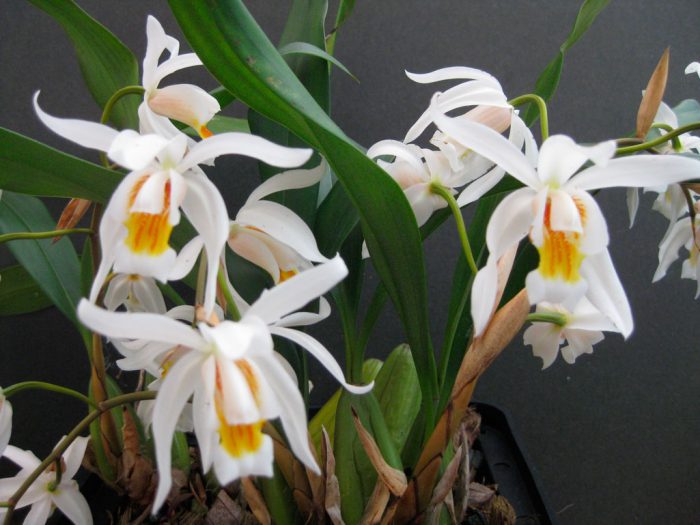
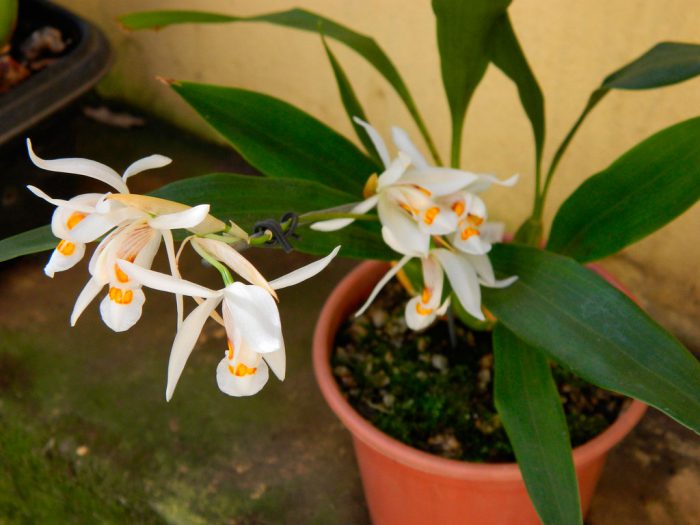
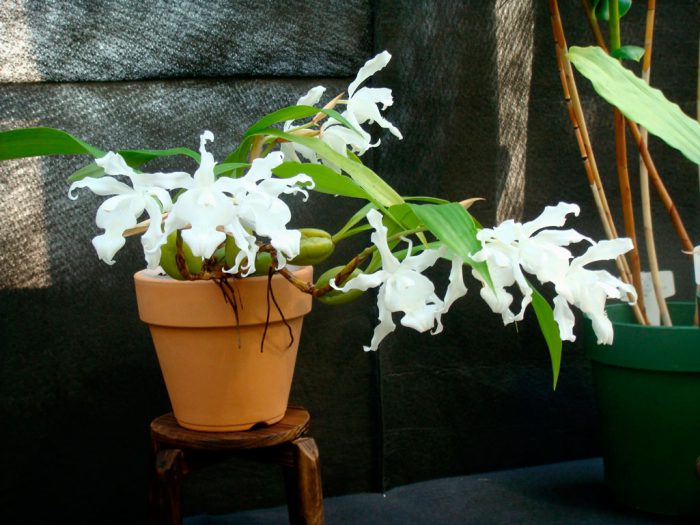


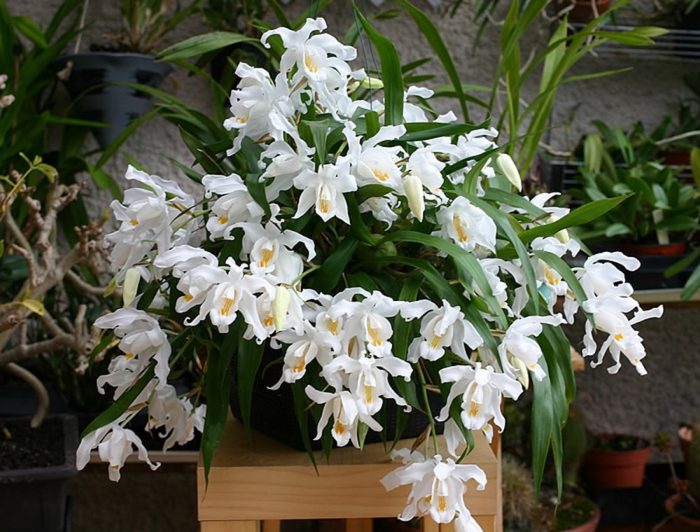

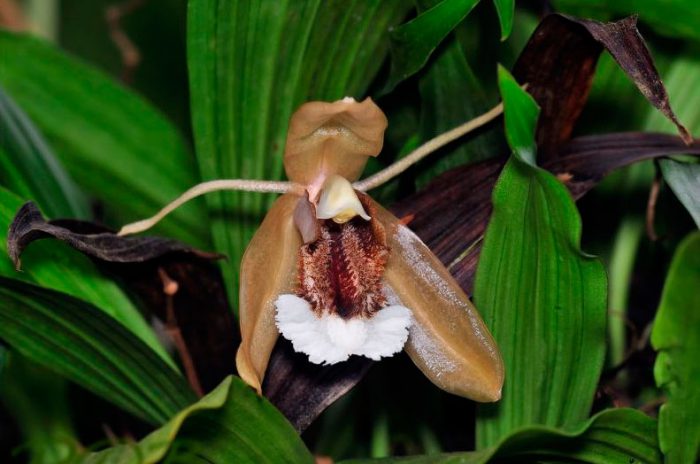

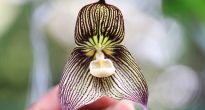

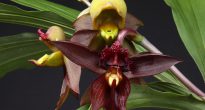

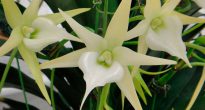
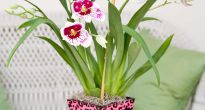

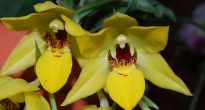

For the normal development and growth of this orchid, special conditions must be created, which is not easy enough.